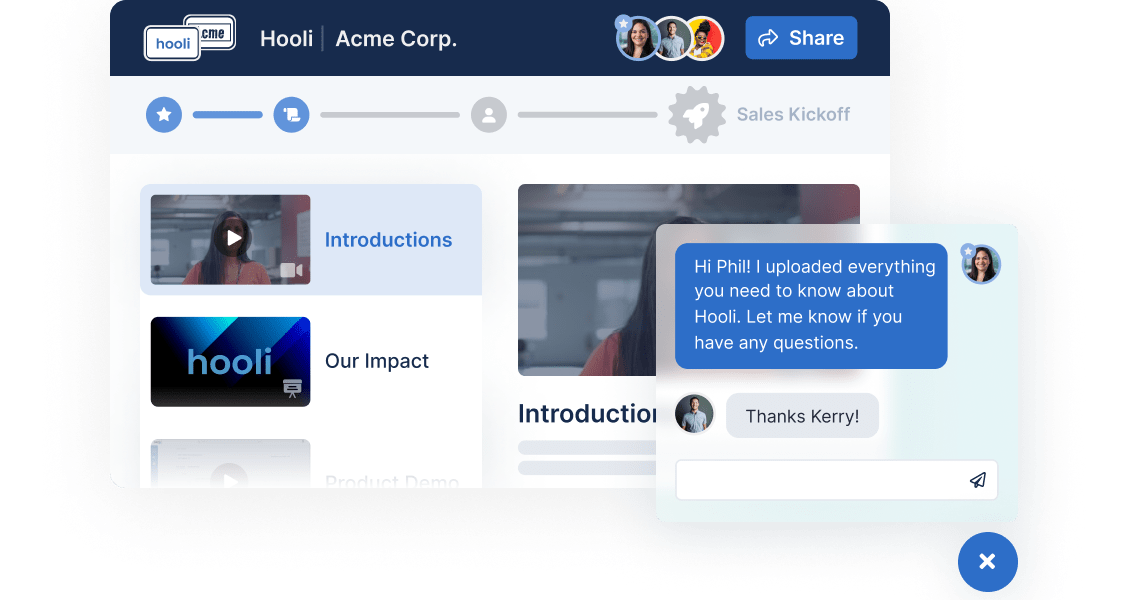Adapting and innovating isn’t a choice in the world of marketing, it’s a necessity. Marketers have to embrace change to keep up with the pace. Popular marketing platforms and social media channels have proven to be effective. But they’re not the be-all and end-all of digital marketing. There’s currently a gap between common marketing platforms and Digital Sales Rooms, a new frontier that promises an exciting avenue for marketers.
In the coming months and quarters, with budgets being further scrutinized and sales productivity continuing to be a top CEO priority, we’re going to see CMOs and marketing teams do more to help sales teams. 56% of CMOs consider improving sales enablement a critical challenge that must be solved in the next 6 months.

To solve this problem, marketing leaders will create more sales content and publish new sales plays. They’ll lean into technologies like Digital Sales Rooms to deliver more value to their buyers and sellers. They’ll funnel marketing budgets from unproven demand generation programs like Google Paid and LinkedIn Paid to proven sales programs with high ROI.
Now, it’s more important than ever to look at how we elevate Digital Sales Rooms to the same level as these other marketing channels. In this post, you’ll find a clear roadmap to help marketers achieve that. You’ll also learn how changing the way you create content will help your organization win more deals and improve your sales productivity metrics. It’s a win-win. Sales will get better content and sales tools and marketers will know the which sales content impacts revenue.
Rethinking marketing content for the digital age
By 2025, Gartner expects 80% of B2B sales interactions between suppliers and buyers to occur in digital channels. Given this dramatic change in buyer behavior, how will marketers respond and transform their approach to creating and curating content. The latest sales innovations, Digital Sales Rooms with GenAI, provides a way for marketers to organize sales assets in one place and intelligently recommend content. The result is empowering sales teams to sell how their buyers want to buy.
These are three of the major components to consider.
#1: Content strategy across the customer journey
The landscape of content creation is undergoing a major shift. A one-size-fits-all approach doesn’t cut it anymore, and buyers struggle to find the information they need. Content needs to be adaptable, informed, and tailored to the varying needs and preferences of prospects. This means you have to start with a deeper understanding of who your audience is and what they want from you. From education to evaluation, experience, and expansion.
Creating content for a digital sales room involves providing resources and materials that guide prospects through different stages of their buyer journey. Here’s how you can structure content based on the categories of education to evaluation, experience, and expansion:
Education
-
- White papers and e-books
- Webinars and on-demand videos
- Case studies and success stories
- Blog posts and articles
- Infographics
Evaluation
-
- Product demos
- Customer testimonials
- Interactive ROI calculators
- Product comparisons
- Trial and pilot programs
Experience
-
- Customer onboarding
- Deep-dive product training and guides
- Adoption use cases
- Regular updates on new features and product enhancements
- Executive summaries
Expansion
-
- Customer expansion stories and testimonials
- Product demonstrations
- Benefits calculators
- Cross sell/upsell success guides
- ROI business justification
These categories help structure content that not only educates and engages prospects but also supports them throughout their journey from initial awareness to becoming long-term, satisfied customers. This strategic construction of content across the buyer’s journey is a new way forward for marketers.
#2: Content organization and publishing
Methods for content publication and distribution are evolving too. Large assets are now often broken down into smaller, digestible chunks. For example, the content of a white paper might be broken down into blog posts or made into a short video series.
The Digital Sales Room is a perfect platform for these forms of content. It offers a space, similar to a social media feed, that makes information consumption less overwhelming for prospects. This new approach to publishing promises a more engaging future for content. It also helps marketers create content that salespeople use. All while making it easier than ever to deliver personalized, relevant assets to buyers.
#3: Content insights and metrics
The importance of accurate metrics in digital marketing cannot be overstated. However, in the context of the Digital Sales Room, marketers need to go beyond traditional metrics like win rates and pipeline conversions.
Engagement metrics hold the key to understanding prospect behavior. For example, knowing how much time a prospect spends on specific slides or how many times they’ve watched a video can provide invaluable insights. With the granular buyer sentiment and engagement data from Digital Sales Rooms, marketers have access to a wealth of new metrics to guide their sales content and go-to-market strategies.
Here are some questions that content insights will provide:
- What content is impacting pipeline?
- What content is progressing deals?
- What content is closing business and impacting revenue?
- How content is impacting win-rates?
- How content is impacting rep participation rates?
- How many sellers are actively engaged using Digital Sales Rooms?
- How much content have the sellers shared with prospects?
- What content do prospects use and not use?
- What content is being used to engage clients?
- What are the most active segments using Digital Sales Rooms?
There are a lot more metrics to track and analyze but this list is a great place to start. It showcases why Digital Sales Rooms are the next marketing frontier.
How marketing can connect the dots for prospects in Digital Sales Rooms
It’s clear that digital sales room requires a thoughtful and dedicated approach to content creation, publishing, and analytics. When you take this route, the content you create can act as a helpful guide. It can empower buyers to go from learning about your brand to making a decision about what they’d like to purchase.
By reimagining content for the Digital Sales Room, marketers can build a more engaging, personalized, and effective connection with prospects. They can create assets that speak directly to prospects’ needs and pain points. Then, the available data makes it possible to continually refine the content and adjust the creation process.
From short videos to product demos and slide decks, various formats can cater to prospects’ preferences. This dynamic method for content offers a tailored experience for each prospect, which enhances conversion potential.
The marketing funnel and Digital Sales Rooms
An important thing to remember is that the Digital Sales Rooms isn’t just relevant for a single stage in the marketing funnel. It plays a crucial role across the entire spectrum, especially past the awareness stage. Once a prospect “raises their hand” to indicate interest, the digital sales room becomes a powerful tool. Here’s a closer look at the impact it can have at each stage:
Consideration stage: Once your prospects have become aware of your offerings and are considering them, the digital sales room becomes an information destination. You may provide resources like videos, eBooks, or reports to show them you understand the problems they’re facing. Presenting these details before a meeting will also help you get ahead of questions and objections.
Decision stage: The digital sales room is crucial when prospects are ready to make a purchase decision. Incorporating product demos, solution briefs, and other personalized recommendations can guide the journey.
Retention and advocacy: Post-purchase, the digital sales room transitions into an engagement hub for customer support, guides, and more. You can also encourage customers to provide feedback and give them an opportunity to share what they love about your product or service with others.
It’s time for you to see what’s possible in the digital sales room
The digital sales room stands as a new frontier in marketing. It offers untapped potential for enhanced prospect engagement and conversion. Its value in the marketing funnel extends beyond a single stage for lead nurturing and conversion. As long as you have to processes in place to embrace the platform and maximize its power.
If you want to take the next step and learn how to enable your teams with modern digital sales rooms, training, coaching, and content, talk to one of our sales enablement experts. SalesHood powers fast-growing companies with our purpose-built, all-in-one sales enablement platform by activating revenue teams to improve sales effectiveness and efficiency.
Get more sales and marketing insights by making one of these posts your next read:
How Buyer Enablement Drives the Lead-To-Customer Journey




